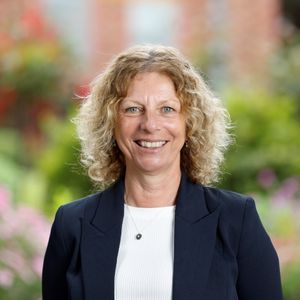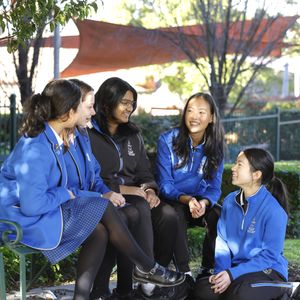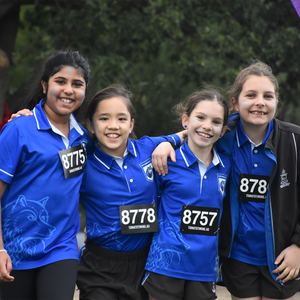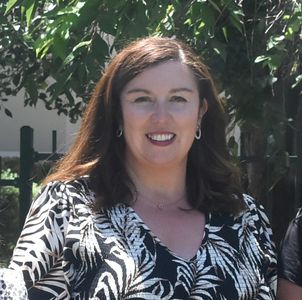Seeing Is Believing: Female Role Models Inspire Girls To Think Bigger
Last Friday 16 October, I was excited to see Yi Xiu Lin, Sabrina Huang, Georgia Edwards and Sienna Cecchetto (Year 11) present their scientific research reports via Zoom to the research community at The Bionics Institute. This is the second year of the program that connects talented Ivanhoe Girls’ Chemistry and Biology students, who are interested to pursue a medical research career, with leading female research mentors at The Bionics Institute in East Melbourne. More information about this collaboration can be found later in this Newsletter.

The School is most appreciative of the time given this year to our students by the female researchers, Rachel and Jessica, and the commitment that The Bionics Institute has made to engage our students with medical research careers. In particular, the School wishes to thank Mr Robert Klupacs, CEO of The Bionics Institute, for partnering in the program and for continuing to make this offer available to our students each year.
The importance of strong female role models, such as Rachel and Jessica, was the topic of a recent Forbes Magazine article by Margie Warrell who is the author of You've Got This! The Life-Changing Power of Trusting Yourself. In her book she reports about the changes in gendered attitudes of students towards scientists. In particular she refers to the draw-a-scientist study (DAST) conducted with over 5000 students in the late 1970s. The students were simply asked to “draw a scientist”. Of the 5000 male and female students only 0.06% drew a female scientist with the remainder drawing a male scientist. This study was repeated in 2018 with 24% of students drawing a female scientist.
While these latter results demonstrate positive societal changes in the gender stereotyping of science careers for women, it still demonstrates the entrenched restrictive gendered stereotypes that are widely held by students and therefore emphasises the need to raise the visibility of female role models for girls and women in science careers. I was interested to know what our Junior School students thought about the role of women in Science and hence the Junior School teachers recreated the DAST study for them late last week. I am delighted to share the following table that clearly shows our students are indeed very open-minded to Science being a profession where women are strongly represented.

Ivanhoe Girls' Junior School Students Draw a Scientist
| Year Level | Male | Female | Non-gendered |
|---|---|---|---|
|
Prep
|
50%
|
50%
|
0%
|
|
Year 1
|
15%
|
85%
|
0%
|
|
Year 2
|
30%
|
70%
|
0%
|
|
Year 3
|
4%
|
92%
|
4%
|
|
Year 4
|
8%
|
85%
|
7%
|
|
Year 5
|
11%
|
59%
|
30%
|
|
Year 6
|
27%
|
50%
|
23%
|
Fortunately, it has long been known that positive role models provide a strong avenue to question gender biases, institutional barriers and negative stereotypes of women pursuing careers in previously male-dominated career fields (See Fyman, K., Lockwood, P. Sadler, P., Tuck, S.). This is one reason why Ivanhoe Girls’ is so excited for our students to be mentored by the female researchers at The Bionics Institute and why we so often bring back former students to speak at assemblies about the successes they have achieved in a range of career fields.
Dr Nina Ansary summarised the frustration so often felt by young women trying to break into male-dominated careers in her recent book entitled, Anonymous Is a Woman: A Global Chronicle of Gender Inequality. She wrote “it’s hard to be what we cannot see.” She strongly believes that not being able to see other women who look and act like them succeeding in areas of interest to them – particularly in the field of STEM, discourages girls from pursuing STEM careers. However, the converse is also true; when girls can readily see women being successful in careers that interest them, it spurs them on to explore and develop that interest.
In September 2015, the McKinsey Global Institute published a report entitled, The power of parity: How advancing women’s equality can add $12 trillion to global growth. If the findings of the Report are to be accepted, it is a compelling case for female and male leaders alike across a range of industries, including the education sector, to work harder to provide female students and young women with leading female role models.
At Ivanhoe Girls’ we look forward to not only continuing the partnership with The Bionics Institute in years to come, we also look forward to extending opportunities to connect our students with female role models in a range of traditionally male-dominated careers. If you believe that you may be able to provide such an opportunity please feel free to email my Executive Assistant, June Porter at jporter@ivanhoegirls.vic.edu.au.
References
- Ansary, N. (2020) Anonymous Is a Woman: A Global Chronicle of Gender Inequality, Revella Press, United States of America.
- Fyman, K., Lockwood, P. Sadler, P., Tuck, S., (2004) To Do or Not to Do: Using Positive and Negative Role Models to Harness Motivation, https://www.researchgate.net/publication/247838950_To_Do_or_Not_to_Do_Using_Positive_and_Negative_Role_Models_to_Harness_Motivation (accessed 12 October 2020)
- McKinsey Global Institute (September 2015) The Power of Parity: How advancing women’s equality can add $12 trillion to global growth, https://www.mckinsey.com/~/media/mckinsey/featured%20insights/employment%20and%20growth/how%20advancing%20womens%20equality%20can%20add%2012%20trillion%20to%20global%20growth/mgi%20power%20of%20parity_full%20report_september%202015.pdf (accessed 12 October 2020)
- Warrell, M. (2020) Seeing Is Believing: Female Role Models Inspire Girls To Think Bigger, https://www.forbes.com/sites/margiewarrell/2020/10/09/seeing-is-believing-female-role-models-inspire-girls-to-rise/#2e75bbd7bf97 (accessed 12 October 2020)
 Book a Tour
Book a Tour
 Enrol Online
Enrol Online
 Prospectus
Prospectus












